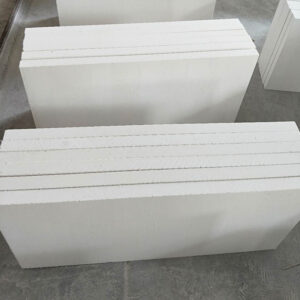The manufacturing process of aluminum silicate board vacuum-formed materials involves several key steps:
- Material Preparation:
- Raw materials, including alumina-silica fibers, binders, additives, and fillers, are carefully selected and mixed to achieve the desired composition.
- The fibers are typically alumina-silica ceramic fibers with suitable lengths and diameters for insulation purposes.
- Binders and additives are added to improve bonding between fibers and enhance the properties of the final board.
- Formulation and Mixing:
- The raw materials are blended in specific proportions according to the desired characteristics of the final board.
- The mixing process ensures uniform distribution of fibers, binders, and additives to achieve homogeneity in the mixture.
- Forming Stage:
- The prepared mixture is then formed into a sheet or board shape using a vacuum-forming process.
- The vacuum-forming technique involves placing the mixed material onto a mold or forming surface while applying a vacuum to draw the material against the mold’s contours.
- The vacuum helps remove air pockets and ensures proper compaction of the material into the desired shape and thickness.
- Drying and Curing:
- The formed boards undergo a drying process to remove excess moisture and solvents. This step is crucial to prevent defects and ensure dimensional stability.
- The boards are then cured or heated to activate the binders and achieve bonding between the fibers. This process strengthens the structure of the board.
- Cutting and Finishing:
- Once cured, the boards are cut to the desired dimensions using cutting tools or machinery.
- Surface finishing, such as grinding or sanding, may be performed to achieve precise thickness and a smooth surface finish.
- Quality Control and Testing:
- The manufactured boards undergo quality control measures, including inspections for dimensional accuracy, density, mechanical strength, and thermal properties.
- Testing procedures assess the boards’ performance characteristics, ensuring they meet industry standards and desired specifications.
- Packaging and Distribution:
- After passing quality checks, the aluminum silicate boards are packaged and prepared for distribution to customers or industries for various engineering applications.
Throughout the manufacturing process, strict adherence to quality control measures, precise formulation, proper curing, and testing procedures are essential to produce high-quality aluminum silicate board vacuum-formed materials with consistent properties suitable for diverse engineering applications requiring high-temperature insulation and thermal management.
What are the primary characteristics that make these materials suitable for high-temperature applications?
Aluminum silicate board vacuum-formed materials possess several primary characteristics that make them highly suitable for high-temperature applications:
- High Thermal Stability: These materials exhibit exceptional resistance to high temperatures, maintaining their structural integrity and insulation properties at elevated temperatures up to 1260°C or even higher in some cases.
- Low Thermal Conductivity: They have low thermal conductivity, effectively insulating against heat transfer. This property is crucial for applications requiring heat containment, such as furnace linings or thermal barriers.
- Excellent Insulation: Aluminum silicate boards provide effective insulation, minimizing heat loss or gain in high-temperature environments. This characteristic is essential for maintaining stable temperatures in industrial processes or equipment.
- Resistance to Thermal Shock: They demonstrate resistance to thermal shock, capable of withstanding rapid temperature changes without cracking or significant degradation. This property is vital in applications involving sudden temperature variations.
- Chemical Stability: These materials exhibit good resistance to various chemicals and corrosive substances, making them suitable for environments where exposure to chemical agents is a concern.
- Lightweight Nature: Aluminum silicate board vacuum-formed materials are relatively lightweight compared to many traditional refractory materials, aluminum silicate board offering ease of handling and installation.
- Customizability: They can be manufactured in various thicknesses and sizes, allowing customization for specific engineering applications, ensuring flexibility in design and installation.
- Durability: Despite their lightweight nature, these materials are durable and capable of withstanding mechanical stress, making them suitable for applications that require both thermal insulation and structural stability.
- Dimensional Stability: These boards maintain their dimensions and shape at high temperatures, ensuring consistency and reliability in their performance over prolonged periods.
- Non-Combustible Nature: Aluminum silicate board materials are non-combustible, contributing to fire safety in high-temperature applications by preventing the spread of flames or ignition.
These primary characteristics collectively make aluminum silicate board vacuum-formed materials ideal for a wide range of high-temperature engineering applications across industries such as metalworking, power generation, petrochemicals, aerospace, and more, where thermal insulation, heat containment, and durability under extreme heat conditions are critical requirements.
